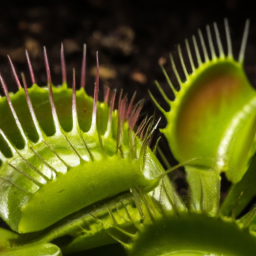The Venus flytrap, a fascinating carnivorous plant known for its unique method of capturing prey, has recently revealed the intricate mechanisms behind its death-grip trigger. This discovery not only enhances our understanding of plant behavior but also opens new avenues for research in botany and ecology. In my experience studying plant adaptations, the Venus flytrap stands out due to its specialized leaves that function as traps. These traps are equipped with sensitive hairs called trichomes, which play a critical role in the plants ability to snatch insects. When an unsuspecting insect brushes against these hairs, it initiates a rapid response that culminates in the trap closing around the prey. This remarkable mechanism has fascinated scientists and nature enthusiasts alike for centuries. Recent research has delved deeper into the physiological processes that govern this rapid movement. Studies show that when the trichomes are triggered, they send electrical signals throughout the plant. This phenomenon, known as action potential, is similar to how nerve cells communicate in animals. The electrical signals lead to a swift influx of water into the cells at the base of the trap, causing it to snap shut in less than a second. This rapid movement is not only a testament to the plants evolutionary adaptations but also highlights the complexity of plant signaling systems. Experts agree that understanding the Venus flytraps trigger mechanism could have broader implications for the field of botany. According to official reports from various botanical institutions, this research could pave the way for advancements in bioengineering and agriculture. For instance, insights gained from the Venus flytraps rapid response system could inspire the development of new technologies that mimic these natural processes, potentially leading to innovative solutions in crop protection and pest management. The implications of this discovery extend beyond the realm of plant biology. As observed in various ecosystems, carnivorous plants like the Venus flytrap play a crucial role in maintaining ecological balance. By capturing and digesting insects, they help regulate insect populations, which can be particularly beneficial in environments where pests are prevalent. This ecological function underscores the importance of preserving these unique plants and their habitats. Moreover, the Venus flytraps mechanism of action raises intriguing questions about the evolution of plant intelligence. Research confirms that plants possess a form of intelligence that allows them to respond to their environment in sophisticated ways. While they lack a nervous system, the ability to process information and react to stimuli suggests a level of awareness that challenges traditional notions of intelligence. This perspective invites a reevaluation of how we understand plant life and its interactions with the surrounding ecosystem. In addition to its ecological significance, the Venus flytrap has cultural and educational value. As one of the most recognizable carnivorous plants, it captivates the interest of students and researchers alike. Educational programs that incorporate the study of Venus flytraps can foster a deeper appreciation for plant biology and biodiversity. Furthermore, the plants unique characteristics make it a popular subject for art and literature, symbolizing the beauty and complexity of nature. As we look to the future, the ongoing research into the Venus flytraps death-grip trigger holds promise for further discoveries. Experts predict that advancements in technology, such as imaging techniques and genetic analysis, will enable scientists to explore the molecular mechanisms underlying the plants rapid movements in greater detail. This could lead to a more comprehensive understanding of how plants adapt to their environments and interact with other organisms. In conclusion, the discovery of the Venus flytraps death-grip trigger not only enhances our understanding of this remarkable plant but also highlights the intricate relationships within ecosystems. As research continues to uncover the complexities of plant behavior, we are reminded of the importance of preserving biodiversity and the natural world. The Venus flytrap serves as a powerful reminder of natures ingenuity and the potential for future innovations inspired by its unique adaptations. As we deepen our understanding of such organisms, we may find new ways to address challenges in agriculture, ecology, and beyond.
TRENDING NOW
WORLD
Global Messaging Trends: Can Local Apps Like Arattai Overtake Giants?
44% 🔥
POLITICS
Accusations fly over whether Republicans or Democrats 'own' shutdown
35% 🔥
POLITICS
Rep. Mike Haridopolos, R-Fla., talks about the government shutdown
34% 🔥
POLITICS
What happens now that the government has shut down. And, a pricing deal with Pfi...
26% 🔥
POLITICS
Married, but no connection: Reality of silent divorces in Indian homes
31% 🔥
POLITICS
Netanyahu's apology to Qatar, phone on Trump's lap: A telling White House photo
38% 🔥
MOST READ
SPORTS
Week 5 NFL odds, lines, betting picks, spreads: 2025 predictions: Model backs Sa...
55% 🔥
SPORTS
Predicting every undefeated college football team's first loss: Will anyone beat...
36% 🔥
SPORTS
Tigers Lefty Tarik Skubal Deserves Second Straight AL Cy Young Award
54% 🔥
SPORTS
Jets Get Official Braelon Allen Injury Diagnosis
61% 🔥
SPORTS
Gill: India won't be 'looking for any easy options' against West Indies
49% 🔥
SPORTS
Phil Mickelson takes a jibe at golf during friendly banter with ex-LIV Golf CEO’...
39% 🔥

